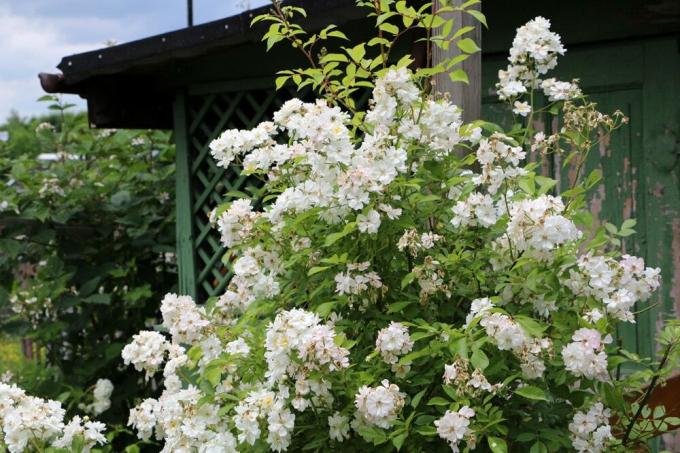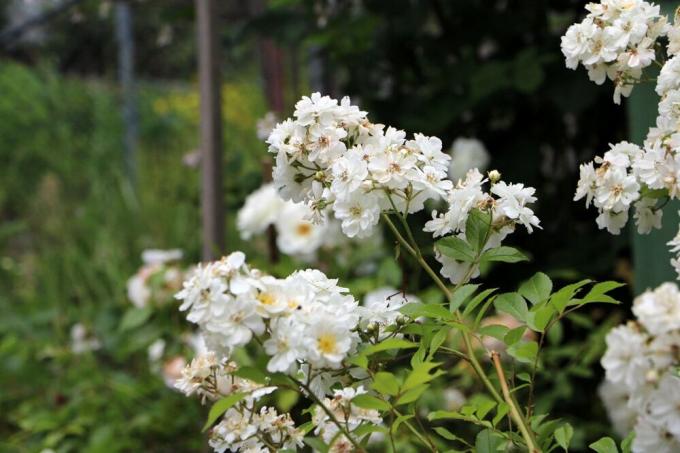

Table of contents
- Location
- substrate
- Plant
- Pour
- Fertilize
- tub culture
- wintering
- waste
- Conclusion
The tufted rose is described by some as easy to care for, by others as demanding. That is probably a matter of interpretation. It cannot do without care, but it does not need excess. The waste can also be dispensed with from time to time. However, if this fails completely, balding can occur. In this respect, the Rosa multiflora does not differ from the requirements of other plants. In the following, interested hobby gardeners can find out exactly what maintenance should look like and what is important when it comes to cutting.
Location
The tufted rose comes from East Asia and is found primarily on slopes, on stony but nutrient-rich soil. In addition, it grows both in the sun and in partial shade and is an important food source for insects due to its abundance of flowers. The deciduous plant withstands frost and wind well due to its origin. Important factors for the location in the garden are derived from the origin and the circumstances:
- loamy, gravelly or sandy soils
- Sun to semi-shade
- not sensitive to wind
- attracts insects and should therefore not be placed too close to the house
Of course, when choosing the planting place for the Rosa multiflora, their size should also be taken into account. Without cutting down the trimmings, the tufted rose can reach a height of up to four or even five meters and a width of two to three meters. If you want to let it grow as unhindered as possible and enjoy the abundance of flowers on a large scale, you should provide it with enough space. In these cases, trellises are also well suited for stabilization. In addition, sunny locations are preferable, as the multi-flowered rose then usually produces more flowers.
substrate
As mentioned, the Tufted Rose prefers a loamy substrate as a basis. Sand or clay should be added to it so that this does not become compacted but remains loose. The soil must therefore be rich in nutrients and not overly wet as well as loose and crumbly. A mixture of garden soil and loosening material is well suited. The heavier the substrate and the more it tends to compact, the higher the proportion of sand or gravel should be. The pH should be between 4 and 6.
In addition, of course, the water drainage must also be ensured. Locations with very high groundwater or a direct proximity to the garden pond can prove to be problematic.
Tip:
In dry soils, we recommend applying bark mulch or gravel. This layer reduces evaporation and also helps keep weeds at bay.
Plant
The tufted rose can be planted in autumn as well as in spring. Plants planted in the fall often produce flowers the following summer. This is rarely the case when planting the multi-flowered rose in spring. However, there are no other points to consider. The Rosa multiflora is planted so that the roots are well covered. The ground should be free from frost.

As a "jump start" for the development of roots, growth and budding, the planting hole can be mixture of the substrate described and an organic fertilizer such as well-rotted compost become. In the first few weeks, it is important to ensure that the soil does not dry out. Waterlogging should be avoided, but flooding with water can stimulate root formation.
Pour
Here the tufted rose does not make high demands after it has grown. Planted outdoors, it usually only needs to be watered during dry periods and to fertilize. Watering can therefore be done sparingly here and only serves to dissolve nutrients and prevent complete drying out. Rainwater would be ideal. Alternatively, soft tap water can also be used. If these two variants are not available, it makes sense to leave the watering water for the multi-flowered rose for a week.
Tip:
Water from the garden pond or aquarium can also be used for occasional watering and light fertilization. The prerequisite here is, of course, that no chemical treatment of the water took place.
Fertilize
Monthly fertilization is allowed from April to August. Mineral and organic fertilizers can be used. It is important here that the soil is examined before the use of fertilizers. In this way, the optimal remedy can be found and over-fertilization can be avoided.
In principle, however, the following are suitable:
- rose fertilizer
- well rotted compost
- organic NPK fertilizer
- flowering fertilizer
- coffee grounds
- horn shavings
- aquarium or pond water
- Plant manure, for example from stinging nettles
If there are no significant deficits in certain nutrients in the soil, the fertilizers can also be alternated. Pond water one month, some coffee grounds or some plant manure the next. In this way, the crop is supplied with a wide range of nutrients all around.
An alternative to monthly fertilization are long-term fertilizers that are specially tailored to the needs of roses or flowering shrubs.
Solid nutrients are easily incorporated into the topsoil or can be added to the irrigation water. Watering after fertilization is just as important for the tufted rose as it is for all other plants. Otherwise, the nutrients cannot be distributed evenly and, in the worst case, can lead to chemical burns.
Tip:
Anyone who has already mixed fertilizer into the soil when planting the Rosa multiflora saves the additional nutrient supply during the first season. Fertilization then usually only has to take place in the second year of growth.
tub culture
As mentioned above, the Tufted Rose can grow into a fairly tall and wide shrub. Nevertheless, within the first few years it is well suited for culture in a bucket. If there is a regular blend and if it is repotted as needed or the soil is changed, it can also be grown permanently in the container.
However, in this case, some special features should be observed during care. These are:
- Ensure good water drainage to prevent waterlogging
- Monthly fertilization, since the small amount of substrate means that fewer nutrients are available than outdoors
- Blend twice a year to control size
- change soil annually or every two years
wintering

Overwintering the tufted rose outdoors is usually possible without any problems, because the Rosa multiflora is hardy down to temperatures of -29 °C. However, some protection should be provided for young plants that have just been planted. The same applies to the culture in the bucket.
It is important in these cases:
- to wrap the above-ground shoots with garden fleece, straw mats or jute
- apply a layer of straw, brushwood or bark mulch to the soil
- to also wrap the tub with garden fleece or suitable materials
- to protect the roots in the planter from frost from below, for example by placing them on Styrofoam or a pallet
As an alternative to these measures, the tufted rose can also be overwintered indoors. Here it is important to ensure that the substrate does not dry out completely and that the plant is not completely dark, cold but as frost-free as possible.
waste
When cutting the tufted rose, there are three variants to distinguish:
- Thin out before flowering
- Cut back after flowering
- Radical cut or rejuvenation cut
When the rose multiflora sprouts again after winter but before it starts budding, dead and cross-growing shoots are cut off. The Multi-Flowered Rose is thinned out as light. If you prefer a particularly bushy and dense look, you can also just remove dead sections. The flowers appear from June to July on both this year's and one-year-old shoots. When these have faded, rose scissors are used again. More cautious this time though. Only the withered shoots are removed.
The radical cut is only necessary if the tufted rose begins to bare or uncontrolled skyrocketed – i.e. when the gentler grooming cuts were missing for a few years are. Radical pruning is also easily tolerated by healthy tufted roses. All shoots are cut off to just above the ground. The measure can be carried out both in spring and in autumn.
Conclusion
Anyone who does a little maintenance and makes a cut every year will enjoy the tufted rose for a long time. Since it serves as a bee pasture and bird sanctuary, the wildlife in the garden also has an advantage. The Rosa multiflora is therefore a relatively easy-care enrichment and can even serve as a privacy screen due to its size and density.
 garden editorial
garden editorial I write about everything that interests me in my garden.
Learn more about Rose

Ground cover roses: care from A – Z
All varieties of ground cover roses are attractive plants with an abundance of flowers consisting of single or double, single or multicolored and delicately scented flowers. Sometimes they even bloom several times a year. They are a low-maintenance and pretty alternative to green ground covers.

Pruning & caring for wild roses | Instructions for Hundsrose & Co.
Wild roses are the easy-care archetype of the rose, but even they cannot do without care in the garden. With the right care, wild roses such as the dog rose or the apple rose produce lush flowers and can be used in a variety of ways in the garden.

Rare Flowers and Bulbs: 20 types of flowers
Experiencing the magic of a species-rich flower meadow is a rare privilege. Intensive agriculture and forestry leave numerous plant and animal species little chance of survival. Reason enough to plant rare flowers and flower bulbs in your own garden and save them from perishing. These 20 types of flowers are floral beauties with a rarity value.

Dune rose, burnet rose, Rosa pimpinellifolia - care instructions
The dune rose or burnet rose is a "rose for all occasions", which brings a wealth of the most beautiful flowers into the garden with the lowest demands. In the article you will learn how easy it is to take care of the versatile rose.

Take care of old roses - transplant and cut properly
Beautiful newly designed garden, only the old roses are now really in the way? Read how to properly transplant and cut old rose bushes.

Potato rose, Rosa rugosa - care, cutting and propagation
The potato rose, originally native to East Asia, is also very popular in local gardens because it is quite robust due to its origin, because in addition to frost hardness, it also has a large salt tolerance, which is particularly important for a location in the front yard, since salt is often spread here in winter becomes.



